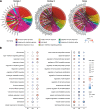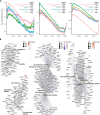Experimental cross-species infection of donkeys with equine hepacivirus and analysis of host immune signatures
- PMID: 35527255
- PMCID: PMC9082851
- DOI: 10.1186/s42522-022-00065-y
Experimental cross-species infection of donkeys with equine hepacivirus and analysis of host immune signatures
Abstract
Background: The Equine Hepacivirus (EqHV) is an equine-specific and liver-tropic virus belonging to the diverse genus of Hepaciviruses. It was recently found in a large donkey (Equus asinus) cohort with a similar seroprevalence (30%), but lower rate of RNA-positive animals (0.3%) compared to horses. These rare infection events indicate either a lack of adaptation to the new host or a predominantly acute course of infection.
Methods: In order to analyze the susceptibility and the course of EqHV infection in donkeys, we inoculated two adult female donkeys and one control horse intravenously with purified EqHV from a naturally infected horse. Liver biopsies were taken before and after inoculation to study changes in the transcriptome.
Results: Infection kinetics were similar between the equids. All animals were EqHV PCR-positive from day three. EqHV RNA-levels declined when the animals seroconverted and both donkeys cleared the virus from the blood by week 12. Infection did not have an impact on the clinical findings and no significant histopathological differences were seen. Blood biochemistry revealed a mild increase in GLDH at the time of seroconversion in horses, which was less pronounced in donkeys. Transcriptomic analysis revealed a distinct set of differentially expressed genes, including viral host factors and immune genes.
Conclusion: To summarize, our findings indicate that donkeys are a natural host of EqHV, due to the almost identical infection kinetics. The different immune responses do however suggest different mechanisms in reacting to hepaciviral infections.
© 2022. The Author(s).
Conflict of interest statement
There are no competing interests.
Figures





References
-
- World Health Organization . global hepatitis report. 2017.
Grants and funding
LinkOut - more resources
Full Text Sources
